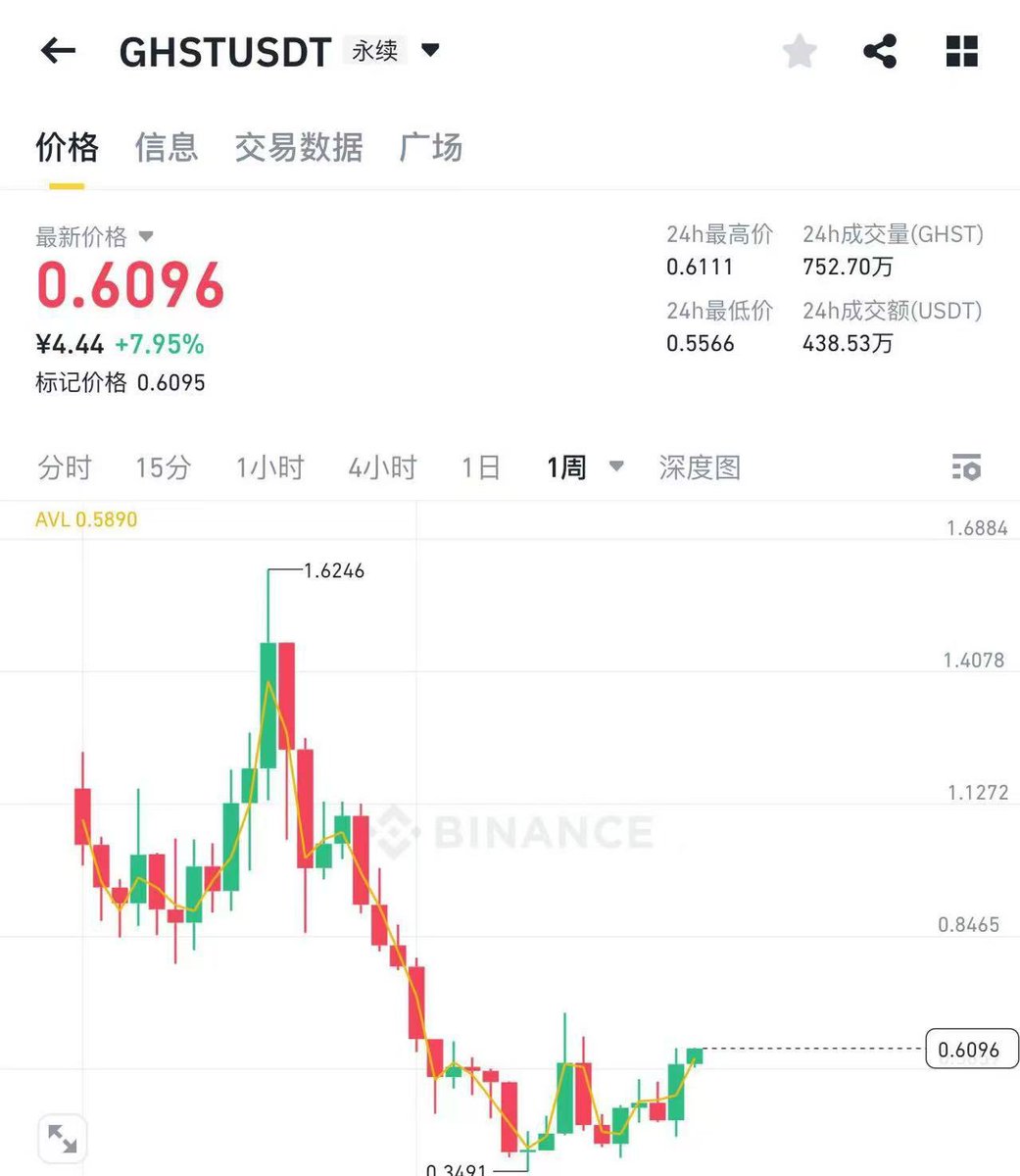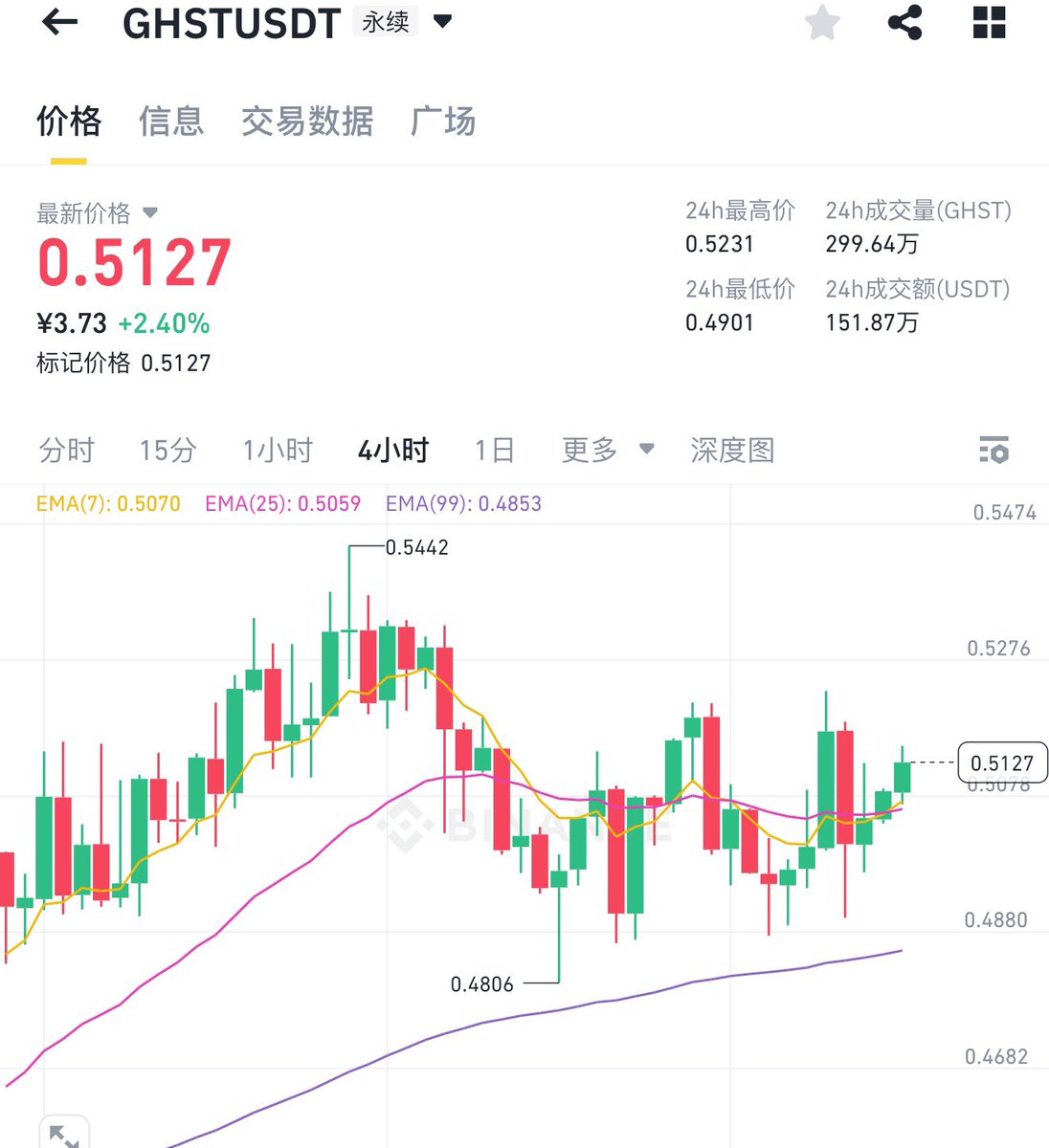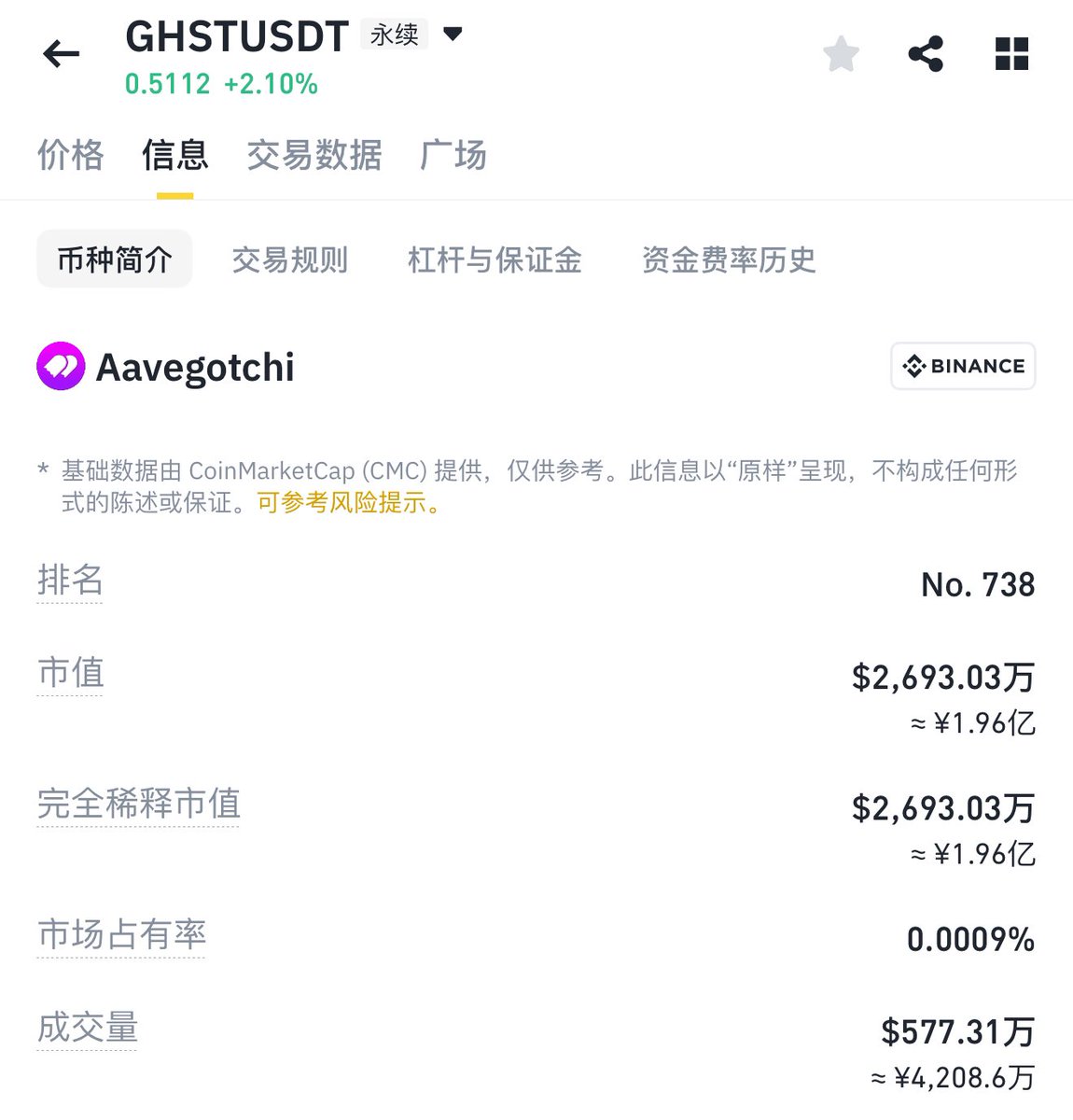
GHST
Aavegotchi koers
$0,51820
-$0,01680
(-3,15%)
Prijsverandering voor de afgelopen 24 uur

Wat vind je vandaag van GHST?
Deel je mening hier door een duim omhoog te geven als je je bullish voelt over een munt of een duim omlaag als je je bearish voelt.
Stem om resultaten te bekijken
Disclaimer
De sociale inhoud op deze pagina ("Inhoud"), inclusief maar niet beperkt tot tweets en statistieken die door LunarCrush worden verstrekt, is afkomstig van derden en wordt alleen voor informatieve doeleinden geleverd "zoals deze is". OKX geeft geen garantie voor de kwaliteit of nauwkeurigheid van de Inhoud en de Inhoud vertegenwoordigt niet de standpunten van OKX. Het is niet bedoeld om (i) beleggingsadvies of een beleggingsaanbeveling te geven; (ii) een aanbod of verzoek om digitale bezitting te kopen, verkopen of te bezitten; of (iii) financieel, boekhoudkundig, juridisch of fiscaal advies. Digitale bezittingen, waaronder stablecoins en NFT's, brengt een hoog risico met zich mee en kan sterk fluctueren. De prijs en prestaties van de digitale bezittingen zijn niet gegarandeerd en kunnen zonder voorafgaande kennisgeving worden gewijzigd.<br></br>OKX geeft geen beleggings- of vermogensadvies. Je moet zorgvuldig overwegen of het verhandelen of bezitten van digitale bezittingen voor jou geschikt is in het licht van je financiële toestand. Raadpleeg je juridische, fiscale of beleggingsadviseur als je vragen hebt over je specifieke situatie. Raadpleeg voor meer informatie onze <a href="/help/terms-of-service">Gebruiksvoorwaarden</a> en <a href="/help/risk-compliance-disclosure">Risicowaarschuwing</a>. Door gebruik te maken van de website van derden ('TPW'), ga je ermee akkoord dat elk gebruik van de TPW onderworpen is aan en beheerst wordt door de voorwaarden van de TPW. Tenzij uitdrukkelijk schriftelijk vermeld, zijn OKX en haar partners ("OKX") op geen enkele manier verbonden met de eigenaar van de exploitant van de TPW. Je gaat ermee akkoord dat OKX niet verantwoordelijk of aansprakelijk is voor verlies, schade en andere gevolgen die voortvloeien uit jouw gebruik van de TPW. Houd er rekening mee dat het gebruik van een TPW kan leiden tot verlies of vermindering van je bezittingen. Het product is mogelijk niet in alle rechtsgebieden beschikbaar.
Aavegotchi marktinformatie
Marktkapitalisatie
Marktkapitalisatie wordt berekend door het circulerende aanbod van een munt te vermenigvuldigen met de laatste prijs.
Marktkapitalisatie = Circulerend aanbod × Laatste prijs
Marktkapitalisatie = Circulerend aanbod × Laatste prijs
Circulerend aanbod
Totale bedrag van een munt dat openbaar beschikbaar is op de markt.
Positie marktkapitalisatie
De positie van een munt in termen van marktkapitalisatie.
Historisch hoogtepunt
Hoogste prijs die een munt heeft bereikt in zijn handelsgeschiedenis.
Historisch dieptepunt
Laagste prijs die een munt heeft bereikt in zijn handelsgeschiedenis.
Marktkapitalisatie
$26,60M
Circulerend aanbod
51.157.239 GHST
96,98% van
52.747.803 GHST
Positie marktkapitalisatie
--
Audits

Laatste audit: 1 mrt 2021
24u hoog
$0,56230
24u laag
$0,51740
Historisch hoogtepunt
$3,8950
-86,70% (-$3,3768)
Laatste update: 2 apr 2024
Historisch dieptepunt
$0,35210
+47,17% (+$0,16610)
Laatste update: 11 mrt 2025
Aavegotchi Feed
De volgende inhoud is afkomstig van .

比特Coffee
#GHST
Uit ervaring gesproken, nadat de #MEME plaat ontploft, is de kans groot dat de [Chain Game] plaat wordt gelanceerd! #GHST is een spelvariëteit met een relatief lage marktkapitalisatie, en na er eens naar te hebben gekeken, is het nog niet in grote hoeveelheden gelanceerd en is het doel om 100%-200% te zien
De marktprijs is 3-50.000 dollar, en het voelt erg veilig!

60,42K
24

Aavegotchi 👻
Je kunt ineenkrimpen. Je kunt blut zijn.
Maar als je geluk hebt... Je kunt beide zijn.
Wijzere woorden zijn nog nooit gesproken 🫡

XIBOT | AAVEGOTCHi
"Je kunt ineenkrimpen. Je kunt blut zijn.
Maar als je geluk hebt, kun je beide zijn."
GenAI + Crypto is er, en @Zora is de printcultuur.
Hier is hoe ik een jpeg-geest in onchain cointent heb veranderd.
Stap één: omarm het ineenkrimpen.
Stap twee: sla het.
👇🧵

4,12K
4

比特Coffee
#GHST
Na een kijkje te hebben genomen, heeft de NFT-ketenspelsector zich de afgelopen dagen opgestapeld, en de kans is groot dat deze naar buiten komt! #GHST is een relatief klein ras qua marktkapitalisatie! Na het bekijken van de positiegegevens is het erg schoon, en deze trend van het verdubbelen van één regel is ook gemakkelijk op te raken!
De marktprijs kocht $ 30.000, met een doelverhoging van 70%-90%!


23,92K
26
GHST-calculator


Aavegotchi prijsprestatie in USD
De huidige koers van Aavegotchi is $0,51820. Gedurende de afgelopen 24 uur, Aavegotchi is met afgenomen tegen -3,14%. Het heeft momenteel een circulerend aanbod van 51.157.239 GHST en een maximaal aanbod van 52.747.803 GHST, waardoor het een volledig verwaterde marktkapitalisatie van $26,60M heeft. Op dit moment bezit de Aavegotchi-munt, de 0 positie in de marktkapitalisatie positie. De Aavegotchi/USD-prijs wordt in real time geüpdatet.
Vandaag
-$0,01680
-3,15%
7 dagen
-$0,01940
-3,61%
30 dagen
+$0,12820
+32,87%
3 maanden
-$0,05540
-9,66%
Populaire Aavegotchi-conversies
Laatste update: 17-05-2025, 16:25
| 1 GHST tot USD | $ 0,52000 |
| 1 GHST tot EUR | € 0,46586 |
| 1 GHST tot PHP | ₱ 29,0178 |
| 1 GHST tot IDR | Rp 8.576,61 |
| 1 GHST tot GBP | £ 0,39148 |
| 1 GHST tot CAD | $ 0,72647 |
| 1 GHST tot AED | AED 1,9100 |
| 1 GHST tot VND | ₫ 13.478,49 |
Over Aavegotchi (GHST)
De beoordeling is een algehele waardering die OKX verzamelt vanaf verschillende bronnen en is alleen bestemd voor intern gebruik. OKX geeft geen garantie wat betreft de kwaliteit of de nauwkeurigheid van een beoordeling. Deze is niet bedoeld als (i) beleggingsadvies of -aanbeveling, (ii) een aanbod voor of verzoek om digitale activa te kopen, te verkopen of aan te houden, of (iii) advies op het gebied van financiën, boekhouding of belastingen. Digitale activa, waaronder stablecoins en NFT's, brengen aanzienlijke risico’s met zich mee. Ze kunnen sterk fluctueren in waarde of zelfs waardeloos worden. De prijzen en bewegingen van digitale activa zijn onvoorspelbaar en kunnen zomaar veranderen. Je digitale activa zijn niet verzekerd tegen mogelijke verliezen. In het verleden behaalde resultaten bieden geen garantie voor de toekomst. OKX garandeert geen terugbetaling van de hoofdsom of rente. OKX geeft geen aanbevelingen voor investeringen of activa. Voordat je besluit om digitale activa te verhandelen of aan te houden, moet je zorgvuldig analyseren of jouw financiële situatie dit toelaat. Raadpleeg bij vragen hierover altijd een juridisch, fiscaal of beleggingsadviseur.
Verder lezen
- Officiële website
- Whitepaper
- Blokverkenner
Informatie over websites van derden
Informatie over websites van derden
Door de website van derden ('TPW') te gebruiken, aanvaard je dat elk gebruik van de TPW onderworpen is aan en geregeld wordt door de voorwaarden van de TPW. Tenzij uitdrukkelijk schriftelijk vermeld, zijn OKX en haar partners ('OKX') op geen enkele wijze verbonden met de eigenaar of exploitant van de TPW. Je stemt ermee in dat OKX niet verantwoordelijk of aansprakelijk is voor verlies, schade en andere gevolgen die voortvloeien uit je gebruik van de TPW. Houd er rekening mee dat het gebruik van een TPW kan leiden tot verlies of waardevermindering van je bezittingen.
Aavegotchi Veelgestelde vragen
Hoe veel is één Aavegotchi vandaag waard?
Momenteel is één Aavegotchi de waarde van $0,51820. Voor antwoorden en inzicht in de prijsactie van Aavegotchi ben je op de juiste plek. Ontdek de nieuwste Aavegotchi grafieken en handel verantwoord met OKX.
Wat is cryptocurrency?
Cryptocurrency's, zoals Aavegotchi, zijn digitale bezittingen die op een openbaar grootboek genaamd blockchains werken. Voor meer informatie over munten en tokens die op OKX worden aangeboden en hun verschillende kenmerken, inclusief live-prijzen en grafieken in real time.
Wanneer zijn cryptocurrency's uitgevonden?
Dankzij de financiële crisis van 2008 nam de belangstelling voor gedecentraliseerde financiën toe. Bitcoin bood een nieuwe oplossing door een veilige digitale bezitting te zijn op een gedecentraliseerd netwerk. Sindsdien zijn er ook veel andere tokens zoals Aavegotchi aangemaakt.
Zal de prijs van Aavegotchi vandaag stijgen?
Bekijk onze Aavegotchi Prijsvoorspellingspagina om toekomstige prijzen te voorspellen en je prijsdoelen te bepalen.
ESG-vermelding
ESG-regelgeving (Environmental, Social, and Governance) voor crypto-bezit is gericht op het aanpakken van hun milieu-impact (bijv. energie-intensieve mining), het bevorderen van transparantie en het waarborgen van ethische bestuurspraktijken om de crypto-industrie op één lijn te brengen met bredere duurzaamheids- en maatschappelijke doelen. Deze regels stimuleren de naleving van normen die risico's beperken en het vertrouwen in digitale bezitting bevorderen.
Details bezittingen
Naam
OKcoin Europe LTD
Identificatiecode relevante juridische entiteit
54930069NLWEIGLHXU42
Naam van het crypto-bezit
Aavegotchi GHST Token
Consensusmechanisme
Aavegotchi GHST Token is present on the following networks: base, ethereum, polygon.
The consensus mechanism of the Base protocol, an Ethereum Layer 2 solution launched by Coinbase, utilizes Optimistic Rollups for scaling built on the Optimism software development kit (SDK). Key Components: 1. Optimistic Rollups: Assumption of Validity: Transactions are assumed valid by default and are processed off-chain. Instead of proving the validity of every transaction, the system assumes they are correct unless challenged. Fraud Proofs: If there is a suspicion of fraud, a challenge mechanism (fault proof) allows anyone to dispute the validity of a transaction within a specific time frame. If a transaction is found to be fraudulent, it is rolled back, and the dishonest actor is penalized. 2. Sequencer: Transaction Ordering: The sequencer is responsible for ordering transactions and creating batches to be processed off-chain. Block Production: It constructs and executes Layer 2 blocks, which are then submitted to Ethereum (Layer 1) for finality. State Updates: Provides transaction confirmations and state updates, ensuring the network's state remains consistent and accurate. 3. Interaction with Ethereum: On-Chain Contracts: Optimistic Rollups use smart contracts deployed on Ethereum to manage rollup blocks, monitor state updates, and track user deposits. Off-Chain Computation: Most computations and state storage occur off-chain, enhancing scalability and reducing fees. 4. Security and Decentralization: Modular OP Stack: Base is built on the open-source OP Stack from Optimism, which is designed to be highly modular and customizable. Commitment Posting: Periodically, the post-transaction state is committed to Ethereum, ensuring the security and integrity of the Layer 2 transactions. Censorship Resistance: The architecture provides censorship resistance equivalent to Ethereum, as it allows direct submission of transactions to the sequencer.
The Ethereum network uses a Proof-of-Stake Consensus Mechanism to validate new transactions on the blockchain. Core Components 1. Validators: Validators are responsible for proposing and validating new blocks. To become a validator, a user must deposit (stake) 32 ETH into a smart contract. This stake acts as collateral and can be slashed if the validator behaves dishonestly. 2. Beacon Chain: The Beacon Chain is the backbone of Ethereum 2.0. It coordinates the network of validators and manages the consensus protocol. It is responsible for creating new blocks, organizing validators into committees, and implementing the finality of blocks. Consensus Process 1. Block Proposal: Validators are chosen randomly to propose new blocks. This selection is based on a weighted random function (WRF), where the weight is determined by the amount of ETH staked. 2. Attestation: Validators not proposing a block participate in attestation. They attest to the validity of the proposed block by voting for it. Attestations are then aggregated to form a single proof of the block’s validity. 3. Committees: Validators are organized into committees to streamline the validation process. Each committee is responsible for validating blocks within a specific shard or the Beacon Chain itself. This ensures decentralization and security, as a smaller group of validators can quickly reach consensus. 4. Finality: Ethereum 2.0 uses a mechanism called Casper FFG (Friendly Finality Gadget) to achieve finality. Finality means that a block and its transactions are considered irreversible and confirmed. Validators vote on the finality of blocks, and once a supermajority is reached, the block is finalized. 5. Incentives and Penalties: Validators earn rewards for participating in the network, including proposing blocks and attesting to their validity. Conversely, validators can be penalized (slashed) for malicious behavior, such as double-signing or being offline for extended periods. This ensures honest participation and network security.
Polygon, formerly known as Matic Network, is a Layer 2 scaling solution for Ethereum that employs a hybrid consensus mechanism. Here’s a detailed explanation of how Polygon achieves consensus: Core Concepts 1. Proof of Stake (PoS): Validator Selection: Validators on the Polygon network are selected based on the number of MATIC tokens they have staked. The more tokens staked, the higher the chance of being selected to validate transactions and produce new blocks. Delegation: Token holders who do not wish to run a validator node can delegate their MATIC tokens to validators. Delegators share in the rewards earned by validators. 2. Plasma Chains: Off-Chain Scaling: Plasma is a framework for creating child chains that operate alongside the main Ethereum chain. These child chains can process transactions off-chain and submit only the final state to the Ethereum main chain, significantly increasing throughput and reducing congestion. Fraud Proofs: Plasma uses a fraud-proof mechanism to ensure the security of off-chain transactions. If a fraudulent transaction is detected, it can be challenged and reverted. Consensus Process 3. Transaction Validation: Transactions are first validated by validators who have staked MATIC tokens. These validators confirm the validity of transactions and include them in blocks. 4. Block Production: Proposing and Voting: Validators propose new blocks based on their staked tokens and participate in a voting process to reach consensus on the next block. The block with the majority of votes is added to the blockchain. Checkpointing: Polygon uses periodic checkpointing, where snapshots of the Polygon sidechain are submitted to the Ethereum main chain. This process ensures the security and finality of transactions on the Polygon network. 5. Plasma Framework: Child Chains: Transactions can be processed on child chains created using the Plasma framework. These transactions are validated off-chain and only the final state is submitted to the Ethereum main chain. Fraud Proofs: If a fraudulent transaction occurs, it can be challenged within a certain period using fraud proofs. This mechanism ensures the integrity of off-chain transactions. Security and Economic Incentives 6. Incentives for Validators: Staking Rewards: Validators earn rewards for staking MATIC tokens and participating in the consensus process. These rewards are distributed in MATIC tokens and are proportional to the amount staked and the performance of the validator. Transaction Fees: Validators also earn a portion of the transaction fees paid by users. This provides an additional financial incentive to maintain the network’s integrity and efficiency. 7. Delegation: Shared Rewards: Delegators earn a share of the rewards earned by the validators they delegate to. This encourages more token holders to participate in securing the network by choosing reliable validators. 8. Economic Security: Slashing: Validators can be penalized for malicious behavior or failure to perform their duties. This penalty, known as slashing, involves the loss of a portion of their staked tokens, ensuring that validators act in the best interest of the network.
Stimuleringsmechanismen en toepasselijke vergoedingen
Aavegotchi GHST Token is present on the following networks: base, ethereum, polygon.
Base, an Ethereum Layer 2 scaling solution, uses a combination of economic incentives and security mechanisms to ensure the integrity and security of transactions. Base leverages Optimistic Rollups to enhance scalability while maintaining security. Incentive Mechanisms 1. Validators and Sequencers: Sequencers: In Base, sequencers are responsible for ordering transactions and creating batches that are processed off-chain. They play a crucial role in maintaining network efficiency and throughput. Validator Rewards: Validators earn rewards for participating in the consensus process. These rewards can include transaction fees and additional protocol incentives. 2. Economic Incentives: Transaction Fees: Sequencers earn transaction fees from users who want their transactions processed. These fees incentivize sequencers to operate honestly and efficiently. Challenge Rewards: Users who successfully challenge invalid transactions by submitting fraud proofs are rewarded. This mechanism encourages the community to actively monitor and ensure the correctness of transactions. 3. Penalties for Malicious Behavior: Economic Penalties: Validators or sequencers that act maliciously, such as including invalid transactions, face economic penalties. These penalties can include forfeiture of staked tokens or other forms of economic loss. Fraud Proofs: If a transaction is challenged and found to be invalid, the dishonest party (sequencer) faces penalties, and the state is reverted. This discourages malicious behavior and ensures network integrity. Fees Applicable on the Base Blockchain Protocol 1. Transaction Fees: Layer 2 Transaction Fees: Users pay fees for transactions processed on the Layer 2 network. These fees are typically lower than those on the Ethereum mainnet due to the reduced computational load on the main chain. Cost Efficiency: By aggregating multiple transactions into a single batch, Base reduces the overall cost per transaction, making it more economical for users. 2. L1 Data Fees: Posting Batches to Ethereum: Periodically, state updates from Layer 2 transactions are posted to the Ethereum mainnet as calldata. This involves a fee, known as the L1 data fee, which covers the gas cost of publishing these state updates on Ethereum. Cost Sharing: The fixed costs of posting state updates to Ethereum are spread across multiple transactions within a batch, reducing the cost burden on individual transactions. 3. Smart Contract Fees: Execution Costs: Fees for deploying and interacting with smart contracts on Base are based on the computational resources required. This ensures that users are charged proportionally for the resources they consume.
Ethereum, particularly after transitioning to Ethereum 2.0 (Eth2), employs a Proof-of-Stake (PoS) consensus mechanism to secure its network. The incentives for validators and the fee structures play crucial roles in maintaining the security and efficiency of the blockchain. Incentive Mechanisms 1. Staking Rewards: Validator Rewards: Validators are essential to the PoS mechanism. They are responsible for proposing and validating new blocks. To participate, they must stake a minimum of 32 ETH. In return, they earn rewards for their contributions, which are paid out in ETH. These rewards are a combination of newly minted ETH and transaction fees from the blocks they validate. Reward Rate: The reward rate for validators is dynamic and depends on the total amount of ETH staked in the network. The more ETH staked, the lower the individual reward rate, and vice versa. This is designed to balance the network's security and the incentive to participate. 2. Transaction Fees: Base Fee: After the implementation of Ethereum Improvement Proposal (EIP) 1559, the transaction fee model changed to include a base fee that is burned (i.e., removed from circulation). This base fee adjusts dynamically based on network demand, aiming to stabilize transaction fees and reduce volatility. Priority Fee (Tip): Users can also include a priority fee (tip) to incentivize validators to include their transactions more quickly. This fee goes directly to the validators, providing them with an additional incentive to process transactions efficiently. 3. Penalties for Malicious Behavior: Slashing: Validators face penalties (slashing) if they engage in malicious behavior, such as double-signing or validating incorrect information. Slashing results in the loss of a portion of their staked ETH, discouraging bad actors and ensuring that validators act in the network's best interest. Inactivity Penalties: Validators also face penalties for prolonged inactivity. This ensures that validators remain active and engaged in maintaining the network's security and operation. Fees Applicable on the Ethereum Blockchain 1. Gas Fees: Calculation: Gas fees are calculated based on the computational complexity of transactions and smart contract executions. Each operation on the Ethereum Virtual Machine (EVM) has an associated gas cost. Dynamic Adjustment: The base fee introduced by EIP-1559 dynamically adjusts according to network congestion. When demand for block space is high, the base fee increases, and when demand is low, it decreases. 2. Smart Contract Fees: Deployment and Interaction: Deploying a smart contract on Ethereum involves paying gas fees proportional to the contract's complexity and size. Interacting with deployed smart contracts (e.g., executing functions, transferring tokens) also incurs gas fees. Optimizations: Developers are incentivized to optimize their smart contracts to minimize gas usage, making transactions more cost-effective for users. 3. Asset Transfer Fees: Token Transfers: Transferring ERC-20 or other token standards involves gas fees. These fees vary based on the token's contract implementation and the current network demand.
Polygon uses a combination of Proof of Stake (PoS) and the Plasma framework to ensure network security, incentivize participation, and maintain transaction integrity. Incentive Mechanisms 1. Validators: Staking Rewards: Validators on Polygon secure the network by staking MATIC tokens. They are selected to validate transactions and produce new blocks based on the number of tokens they have staked. Validators earn rewards in the form of newly minted MATIC tokens and transaction fees for their services. Block Production: Validators are responsible for proposing and voting on new blocks. The selected validator proposes a block, and other validators verify and validate it. Validators are incentivized to act honestly and efficiently to earn rewards and avoid penalties. Checkpointing: Validators periodically submit checkpoints to the Ethereum main chain, ensuring the security and finality of transactions processed on Polygon. This provides an additional layer of security by leveraging Ethereum's robustness. 2. Delegators: Delegation: Token holders who do not wish to run a validator node can delegate their MATIC tokens to trusted validators. Delegators earn a portion of the rewards earned by the validators, incentivizing them to choose reliable and performant validators. Shared Rewards: Rewards earned by validators are shared with delegators, based on the proportion of tokens delegated. This system encourages widespread participation and enhances the network's decentralization. 3. Economic Security: Slashing: Validators can be penalized through a process called slashing if they engage in malicious behavior or fail to perform their duties correctly. This includes double-signing or going offline for extended periods. Slashing results in the loss of a portion of the staked tokens, acting as a strong deterrent against dishonest actions. Bond Requirements: Validators are required to bond a significant amount of MATIC tokens to participate in the consensus process, ensuring they have a vested interest in maintaining network security and integrity. Fees on the Polygon Blockchain 4. Transaction Fees: Low Fees: One of Polygon's main advantages is its low transaction fees compared to the Ethereum main chain. The fees are paid in MATIC tokens and are designed to be affordable to encourage high transaction throughput and user adoption. Dynamic Fees: Fees on Polygon can vary depending on network congestion and transaction complexity. However, they remain significantly lower than those on Ethereum, making Polygon an attractive option for users and developers. 5. Smart Contract Fees: Deployment and Execution Costs: Deploying and interacting with smart contracts on Polygon incurs fees based on the computational resources required. These fees are also paid in MATIC tokens and are much lower than on Ethereum, making it cost-effective for developers to build and maintain decentralized applications (dApps) on Polygon. 6. Plasma Framework: State Transfers and Withdrawals: The Plasma framework allows for off-chain processing of transactions, which are periodically batched and committed to the Ethereum main chain. Fees associated with these processes are also paid in MATIC tokens, and they help reduce the overall cost of using the network.
Begin van de periode waarop de informatieverschaffing betrekking heeft
2024-04-20
Einde van de periode waarop de informatie betrekking heeft
2025-04-20
Energierapport
Energieverbruik
200.02636 (kWh/a)
Energieverbruiksbronnen en -methodologieën
The energy consumption of this asset is aggregated across multiple components:
To determine the energy consumption of a token, the energy consumption of the network(s) base, ethereum, polygon is calculated first. Based on the crypto asset's gas consumption per network, the share of the total consumption of the respective network that is assigned to this asset is defined. When calculating the energy consumption, we used - if available - the Functionally Fungible Group Digital Token Identifier (FFG DTI) to determine all implementations of the asset of question in scope and we update the mappings regulary, based on data of the Digital Token Identifier Foundation.
GHST-calculator


















Socials